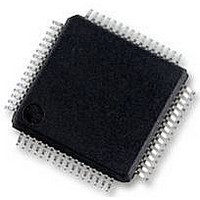S9S12HY64J0MLH Freescale Semiconductor, S9S12HY64J0MLH Datasheet - Page 378

S9S12HY64J0MLH
Manufacturer Part Number
S9S12HY64J0MLH
Description
MCU 64K FLASH AUTO 64-LQFP
Manufacturer
Freescale Semiconductor
Series
HCS12r
Datasheet
1.S9S12HA32J0CLL.pdf
(792 pages)
Specifications of S9S12HY64J0MLH
Core Processor
HCS12
Core Size
16-Bit
Speed
32MHz
Connectivity
CAN, EBI/EMI, I²C, IrDA, LIN, SCI, SPI
Peripherals
LCD, Motor control PWM, POR, PWM, WDT
Number Of I /o
50
Program Memory Size
64KB (64K x 8)
Program Memory Type
FLASH
Eeprom Size
4K x 8
Ram Size
4K x 8
Voltage - Supply (vcc/vdd)
4.5 V ~ 5.5 V
Data Converters
A/D 6x10b
Oscillator Type
Internal
Operating Temperature
-40°C ~ 125°C
Package / Case
64-LQFP
Controller Family/series
S12
No. Of I/o's
50
Ram Memory Size
4KB
Cpu Speed
64MHz
No. Of Timers
2
Rohs Compliant
Yes
Processor Series
S12HY
Core
HCS12
3rd Party Development Tools
EWHCS12
Development Tools By Supplier
DEMO9S12HY64
Lead Free Status / RoHS Status
Lead free / RoHS Compliant
Available stocks
Company
Part Number
Manufacturer
Quantity
Price
Company:
Part Number:
S9S12HY64J0MLH
Manufacturer:
Freescale Semiconductor
Quantity:
10 000
- Current page: 378 of 792
- Download datasheet (4Mb)
Inter-Integrated Circuit (IICV3) Block Description
10.4.1.2
The first byte of data transfer immediately after the START signal is the slave address transmitted by the
master. This is a seven-bit calling address followed by a R/W bit. The R/W bit tells the slave the desired
direction of data transfer.
If the calling address is 10-bit, another byte is followed by the first byte.Only the slave with a calling
address that matches the one transmitted by the master will respond by sending back an acknowledge bit.
This is done by pulling the SDA low at the 9th clock (see
No two slaves in the system may have the same address. If the IIC bus is master, it must not transmit an
address that is equal to its own slave address. The IIC bus cannot be master and slave at the same
time.However, if arbitration is lost during an address cycle the IIC bus will revert to slave mode and operate
correctly even if it is being addressed by another master.
10.4.1.3
As soon as successful slave addressing is achieved, the data transfer can proceed byte-by-byte in a
direction specified by the R/W bit sent by the calling master
All transfers that come after an address cycle are referred to as data transfers, even if they carry sub-address
information for the slave device.
Each data byte is 8 bits long. Data may be changed only while SCL is low and must be held stable while
SCL is high as shown in
transferred first. Each data byte has to be followed by an acknowledge bit, which is signalled from the
receiving device by pulling the SDA low at the ninth clock. So one complete data byte transfer needs nine
clock pulses.
If the slave receiver does not acknowledge the master, the SDA line must be left high by the slave. The
master can then generate a stop signal to abort the data transfer or a start signal (repeated start) to
commence a new calling.
If the master receiver does not acknowledge the slave transmitter after a byte transmission, it means 'end
of data' to the slave, so the slave releases the SDA line for the master to generate STOP or START
signal.Note in order to release the bus correctly,after no-acknowledge to the master,the slave must be
immediately switched to receiver and a following dummy reading of the IBDR is necessary.
10.4.1.4
The master can terminate the communication by generating a STOP signal to free the bus. However, the
master may generate a START signal followed by a calling command without generating a STOP signal
first. This is called repeated START. A STOP signal is defined as a low-to-high transition of SDA while
SCL at logical 1 (see
The master can generate a STOP even if the slave has generated an acknowledge at which point the slave
must release the bus.
378
1 = Read transfer, the slave transmits data to the master.
0 = Write transfer, the master transmits data to the slave.
Slave Address Transmission
Data Transfer
STOP Signal
Figure
Figure
10-10).
MC9S12HY/HA-Family Reference Manual, Rev. 1.04
10-10. There is one clock pulse on SCL for each data bit, the MSB being
Figure
10-10).
Freescale Semiconductor
Related parts for S9S12HY64J0MLH
Image
Part Number
Description
Manufacturer
Datasheet
Request
R
Part Number:
Description:
Manufacturer:
Freescale Semiconductor, Inc
Datasheet:
Part Number:
Description:
Manufacturer:
Freescale Semiconductor, Inc
Datasheet:
Part Number:
Description:
Manufacturer:
Freescale Semiconductor, Inc
Datasheet:
Part Number:
Description:
Manufacturer:
Freescale Semiconductor, Inc
Datasheet:
Part Number:
Description:
Manufacturer:
Freescale Semiconductor, Inc
Datasheet:
Part Number:
Description:
Manufacturer:
Freescale Semiconductor, Inc
Datasheet:
Part Number:
Description:
Manufacturer:
Freescale Semiconductor, Inc
Datasheet:
Part Number:
Description:
Manufacturer:
Freescale Semiconductor, Inc
Datasheet:
Part Number:
Description:
Manufacturer:
Freescale Semiconductor, Inc
Datasheet:
Part Number:
Description:
Manufacturer:
Freescale Semiconductor, Inc
Datasheet:
Part Number:
Description:
Manufacturer:
Freescale Semiconductor, Inc
Datasheet:
Part Number:
Description:
Manufacturer:
Freescale Semiconductor, Inc
Datasheet:
Part Number:
Description:
Manufacturer:
Freescale Semiconductor, Inc
Datasheet:
Part Number:
Description:
Manufacturer:
Freescale Semiconductor, Inc
Datasheet:
Part Number:
Description:
Manufacturer:
Freescale Semiconductor, Inc
Datasheet:











